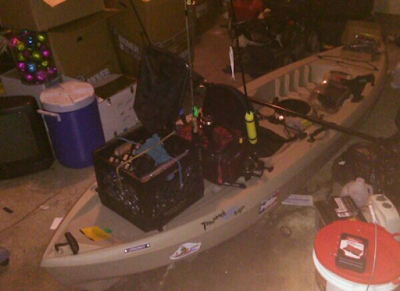So, what is kayak fishing really?
Well, according to Wikipedia:
Kayak fishing is fishing from a kayak. The kayak has long been a means of transportation and a stealth means of approaching easily spooked fish, such as cobia and flounder. Kayak fishing has gained popularity in recent times due to its broad appeal as an environmentally friendly and healthy method of transportation, as well as its relatively low cost of entry compared to motorized boats.
* Special thanks to Wikipedia.org for the brief description.
We, and not just myself, have been referred to as kayak fishermen, kayak anglers, the plastic Navy, and so on. We have also been called crazy, insane, stupid, reckless, and territorial. But, the one thing I try to include in some of my articles, are some of the places I like to fish. I like to think that the ocean is a vast territory that should be enjoyed by everybody regardless of the type of kayak that you chose to buy. Because not everyone can find a good bargain, or afford a "high end" kayak that has pedals or a motor on it.
I've also noticed that some of the groups that I belong to on Facebook, as well as the club that I fish with in Rhode Island (the largest in New England), they are extremely private, territorial, and downright secretive for the most part. Not really sure why everybody's so secretive all of sudden. I don't believe any area to be totally "fished out". Fish, like kayak anglers themselves, tend to be on the move constantly, looking for the best places to forage for food (or, find fish).
Lately, a group on a popular social media site that's based out of Rhode Island, was once a "private group". But now the group has grown in the last few months, and has now been changed from a private group, to a "secret group". They've become a little "territorial" in their membership rules, that anybody who "leaks out" their secret launch spots, or private meets, will be booted out of the club - permanently.
When I'm writing one of my blogs, I like to include places that are my favorite fishing spots on a constant basis. I don't mind giving out my trade secrets. If they worked for me, maybe they will work for you, or better yet, maybe you will have better luck than I did. I will also include some of the rigs that I used to catch my fish that day/night. Some of the hot spots that I frequent in neighboring Rhode Island on a regular basis are Newport Harbor, Fort Adams, Fort Wetherill, Camp Cronin, Ninigret Pond, and Quonchonataug (Quonny) Pond. These are known producers for striped bass - both schoolie & keeper sized.
Some of my favorite rigs that I use in the early Spring are Marabou Crappie Jigs with a 1/16th oz head. The body is orange, the head is black with white "eyes", and the tail has brown feathers. I then tie 15"-17" of clear 10 lb. mono fishing line to the head.
Photo Credit #1: Jeff Hall
This setup is the same killer setup I've angered and annoyed a lot of other kayak fishermen once I get setup in a spot away from their group. I remember coming into an area where there were already 10 people present trying to catch a few schoolie stripers. I pull up real slow with my poles already rigged with the setup I just mentioned, and after the 3rd, or 4th cast, I started catching one right after another in close succession. I also remember pissing off a few guys who then packed up their gear and paddled out totally disgusted with a "new guy" taking over their spot(s).
Photo Credit #2: Jeff Hall
In the early Summer, I like to use Al Gag's Whip-It Eels with a 1/4 oz. jig head in chartreuse yellow. I like to use these at the point at Fort Adams in Newport,RI. I've had great success with Al's lures - both the Whip-It Fish & Whip-It Eels.
The author shown with a nice schoolie striper caught with a 1/4 oz. chartreuse yellow Al Gag's Whip-It Eel at Fort Adams in Newport,RI in early June 2017.
Photo Credit #3: Mona Rodriguez
Another nice schoolie striper caught by the author in the cove at Fort Adams in Newport,RI in early June 2017 with fellow RISAA members Mona Rodriguez & David Grady (not pictured).
Photo Credit #4: Jeff Hall
So, don't be so secretive with your fishing spots. Kayak fishing should be enjoyed by everyone - whether they are young or old. Our youth today, may still be actively pursuing their trophy catch in tomorrow's future. We all owe them that much.
Until then, keep those lines wet & tight! - J.





















































